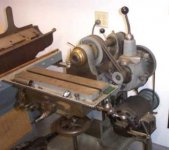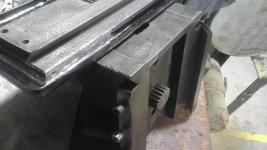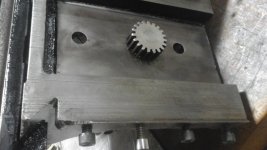M.B. Naegle
Diamond
- Joined
- Feb 7, 2011
- Location
- Conroe, TX USA
So...
I picked up another project... It started here:
Help identify small horizontal mill
So now my bleeding heart is waiting for the freight truck. Luckily since it's practically a micro-mill, shipping wasn't too bad. Once it arrives, I'll get some new pictures.
I got it as it's the right size for my little shop at home. It's missing the spindle parts, but was fairly priced, so best case I'm looking to recreate the old step-pulley drive and run it off of the line-shaft system I'm putting together. Worst case, I can redesign a practical spindle for it. Given the number of projects I have going right now, I won't be starting on this one until I can get some other stuff done, but I wanted to start the research/planning process. I'd appreciate any help I can get from any other #5 owners out there.
Starting with what I know about the mill: It's a Brainard #5 horizontal mill made sometime between 1871 and 1899. The missing parts are long gone, and there are not many mills like it around to borrow parts or information from. Vintagemachinery.org has a Brainard catalog with a couple paragraphs about this mill and one small picture. It says that this mill was designed for light duty brass work, such as for electrical components, so there never was an over-arm support or a back-gear.
The spindle had a cone pulley drive with five steps and the catalog gives good information for what RPM was needed to drive the machine. With that I'll do some math to figure what the speeds were and dimensions of the missing cone pulleys. The spindle rode in bronze bearings which are still in the head-stock, so all that really needs to be made is a cone pulley and a spindle. I'll get some figures by scaling the cone pulley in the catalog picture and see if there might be a cone pulley set from another machine like an old lathe that could be adapted. IMO the spindle would be easy to produce from some kind of tool steel. Ideally I'll grind the bearing surfaces and tool register to be concentric. I'm guessing Brown and Sharpe #7 would be an appropriate tool taper, and it's one I'm well stocked in end-mills and misc. holders, I'll just need to piece together another set of collets.
The knee, while not on the machine, seems to all be there with the exception of one bolt-on gib to hold the knee to the column, one ball crank, and the vertical adusting wheel and screw. All of which should be easy to replace. Some pictures online of similar mills show a power feed mechanism that hung off of the back of the spindle, but I'm not certain that this one had it as the table doesn't seem to have had it's half of that system, so hand-feed only.
The side door is missing which is sad, but I'll make something out of a plate of steel to fill the hole. Perhaps one day as 3D printing and casting technology get more economical and easy to work with, I can model up a raised letter door and replace it. This picture is not of my mill but was posted in the prior thread.

I'm already in the process of building some smaller overhead clutch jack-shafts for my tool-and-cutter-grinder and bench grinder, and I think this mill would use a similar size bearing/clutch set so I'll make one for it while I'm at it. The clutch I'm making for my Whitcomb Blaisdell lathe will have a reversing clutch so I might do the same with this mill too. Of course, I could simplify the drive with a DC motor or VFD driven AC motor hanging off the side of the column, and that might get it cutting chips sooner... but that's not as fun as playing with leather belts hanging from the ceiling. Also I'm not trying to DIY a little home-shop-machinist bench mill so much as complete a piece of history that could then be useful, which will involve some DIY by a machinist in a home shop. Semantics is everything.
Also I'm not trying to DIY a little home-shop-machinist bench mill so much as complete a piece of history that could then be useful, which will involve some DIY by a machinist in a home shop. Semantics is everything.
The previous owner did find these pictures of the same model of mill on a different forum. Not sure who owns it but they're good reference for a complete machine.


More pictures coming when the machine arrives.
I picked up another project... It started here:
Help identify small horizontal mill
So now my bleeding heart is waiting for the freight truck. Luckily since it's practically a micro-mill, shipping wasn't too bad. Once it arrives, I'll get some new pictures.
I got it as it's the right size for my little shop at home. It's missing the spindle parts, but was fairly priced, so best case I'm looking to recreate the old step-pulley drive and run it off of the line-shaft system I'm putting together. Worst case, I can redesign a practical spindle for it. Given the number of projects I have going right now, I won't be starting on this one until I can get some other stuff done, but I wanted to start the research/planning process. I'd appreciate any help I can get from any other #5 owners out there.
Starting with what I know about the mill: It's a Brainard #5 horizontal mill made sometime between 1871 and 1899. The missing parts are long gone, and there are not many mills like it around to borrow parts or information from. Vintagemachinery.org has a Brainard catalog with a couple paragraphs about this mill and one small picture. It says that this mill was designed for light duty brass work, such as for electrical components, so there never was an over-arm support or a back-gear.
The spindle had a cone pulley drive with five steps and the catalog gives good information for what RPM was needed to drive the machine. With that I'll do some math to figure what the speeds were and dimensions of the missing cone pulleys. The spindle rode in bronze bearings which are still in the head-stock, so all that really needs to be made is a cone pulley and a spindle. I'll get some figures by scaling the cone pulley in the catalog picture and see if there might be a cone pulley set from another machine like an old lathe that could be adapted. IMO the spindle would be easy to produce from some kind of tool steel. Ideally I'll grind the bearing surfaces and tool register to be concentric. I'm guessing Brown and Sharpe #7 would be an appropriate tool taper, and it's one I'm well stocked in end-mills and misc. holders, I'll just need to piece together another set of collets.
The knee, while not on the machine, seems to all be there with the exception of one bolt-on gib to hold the knee to the column, one ball crank, and the vertical adusting wheel and screw. All of which should be easy to replace. Some pictures online of similar mills show a power feed mechanism that hung off of the back of the spindle, but I'm not certain that this one had it as the table doesn't seem to have had it's half of that system, so hand-feed only.
The side door is missing which is sad, but I'll make something out of a plate of steel to fill the hole. Perhaps one day as 3D printing and casting technology get more economical and easy to work with, I can model up a raised letter door and replace it. This picture is not of my mill but was posted in the prior thread.

I'm already in the process of building some smaller overhead clutch jack-shafts for my tool-and-cutter-grinder and bench grinder, and I think this mill would use a similar size bearing/clutch set so I'll make one for it while I'm at it. The clutch I'm making for my Whitcomb Blaisdell lathe will have a reversing clutch so I might do the same with this mill too. Of course, I could simplify the drive with a DC motor or VFD driven AC motor hanging off the side of the column, and that might get it cutting chips sooner... but that's not as fun as playing with leather belts hanging from the ceiling.
 Also I'm not trying to DIY a little home-shop-machinist bench mill so much as complete a piece of history that could then be useful, which will involve some DIY by a machinist in a home shop. Semantics is everything.
Also I'm not trying to DIY a little home-shop-machinist bench mill so much as complete a piece of history that could then be useful, which will involve some DIY by a machinist in a home shop. Semantics is everything.The previous owner did find these pictures of the same model of mill on a different forum. Not sure who owns it but they're good reference for a complete machine.


More pictures coming when the machine arrives.



 . Perhaps the old parts were modified or scrapped before they gave up on it or otherwise lost interest? It's all speculation on my part, but if possible I'd like to at least know what it used to be, and then IF I were to "update" it in some way (the table surface and vertical movement parts for example), I could do so in a way that didn't permanently change the machine.
. Perhaps the old parts were modified or scrapped before they gave up on it or otherwise lost interest? It's all speculation on my part, but if possible I'd like to at least know what it used to be, and then IF I were to "update" it in some way (the table surface and vertical movement parts for example), I could do so in a way that didn't permanently change the machine.
























 The other option would be to bolt a solid 1/4-3/8" steel plate between the bottom of the new table the remaining original table, which might be the best compromise. Thoughts?
The other option would be to bolt a solid 1/4-3/8" steel plate between the bottom of the new table the remaining original table, which might be the best compromise. Thoughts?